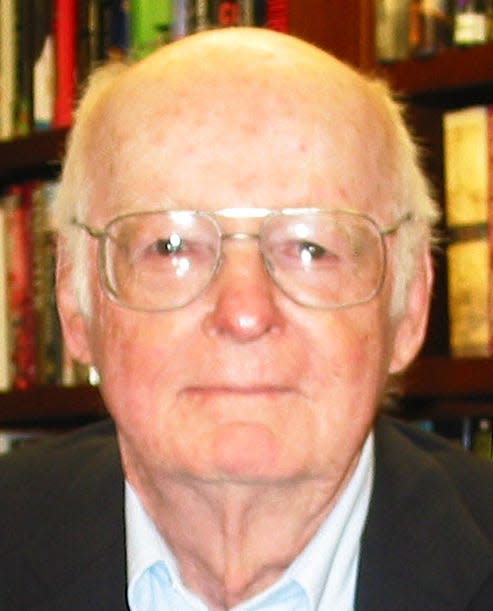Dick Magee: A penny for my thoughts
I found a penny awhile back. It was half hidden in the grit next to the curb by the Kroger store. I bent over, scooped it up, gave it a look. It had lost its shine, was scratched, rough to the touch, worn out. I had to squint to see it had been minted in 1932. It was almost my age. We had something in common — age and looks. Now some folks wonder why an old gent would stoop to pick up a penny — and risk falling on his noggin. Well, it’s because a penny is important.
It’s under attack — and needs me to fight back.
While our representatives in Washington don’t do much more than carp at one another, a few found time to fuss about the penny. There’s a movement afoot to purge the penny from all that is pecuniary. In short, take it out of circulation. It’s supposed to happen this year.

Advocates urging the purging of the penny say our penny is useless; we can’t buy anything for a penny. I say we can’t buy much for a dollar either if that’s the measure. They claim it costs more than a penny to mint a penny. Could be. But let’s not be “penny wise and pound foolish.” There’s more to the penny than meets the eye.
But first let’s look at the penny-snatchers’ claim that the coin is a drag on our economy. They quote a study funded by The National Association of Convenience Stores. Working from Federal Reserve data, the study found that handling pennies during a cash transaction takes two seconds — and in a year, there can be 107 billion of such transactions. Whew. The study then concludes all this fussing with pennies takes time and thereby costs the economy $2 billion a year.
Did you follow all that gobbledygook? I couldn’t keep track of all the zeros. Thank heavens they didn’t include the time it takes to find the dropped penny that rolls under the counter. Nor did they estimate the cost to us when the cents in a sale are rounded up to a nickel. But hang on, there’s talk about nixing the nickel next! The mint loses on that, too — but it still makes an annual profit of over a half billion dollars!
The penny is more than a coin. It’s an iconic piece of America — a part of my growing up. It’s like mom and apple pie. In 1936 Bing Crosby’s crooning “Every time it rains, it rains pennies from heaven” put the song on the Top Song Chart for 10 straight weeks. You don’t mess with stuff from heaven. And let’s not forget pennies and the piggy bank. Plunkin’ pennies in that bank got me started down the right track. Arithmetic started to make “cents.” Pushin’ pennies around showed me how they could grow into nickels and dimes. When the bank was full, I’d pour the coins out on the kitchen table and start wrappin’ ‘em into those 50-cent paper rolls. At the same time I’d keep an eye out for coins to add to my penny collection. Stuffing a penny into an empty slot in my Lincoln Head Cent Collection book was cause for high-fives all round. My motto was “In for a penny, in for a pound!”
Those penny rolls stacked up on the table looked like the gold bars in the Fort Knox Gold Depository. I was a person of property. I’d put the rolls in a sturdy sack, haul ‘em to the bank, push ‘em cross the counter, and watch the teller add to my passbook. I didn’t forget Ben Franklin’s “A penny saved is a penny earned.” I remembered, “Find a penny, pick it up; all day long you’ll have good luck.” I found change in the cushions of the couch, in parking lots, under the bleachers at the ballpark. I always had a penny in hand for a treat. I could buy a Tootsie Roll for a penny, or a gumball, or a sucker on a stick. I could stick a penny in a slot, turn a crank on a vending machine and get a fist-full of peanuts.
We’d put a penny on the track at the old Klinger Lake station and watch a train make it flatter than a pancake. I’m looking at one right now. It’s on the bookshelf, on top of my coin collection books, next to my old piggy bank. The past is part of the present. The penny and its big brothers, the nickels, dimes and quarters, were important parts of my growing up. They helped me understand trickle-down economics and the perils of deficit spending.
The anti-penny crowd focuses on transitory extrinsic values like cost and convenience. They ignore the substantive intrinsic values. The penny is historic. It’s been in our pockets, ready to serve since 1787. It’s been counted, dropped and lost by our Founding Fathers. Lincoln is its patron. It is indestructible. Even when my young son swallowed one it survived — and came out just fine at the other end.
Finally, you might wonder about the cost of writing this column based on the imagined “penny for my thoughts” scale. The researchers at the University of Southern California’s Laboratory of Neuro Imaging think they have the answer. They conclude that the average person has 49 thoughts per minute. My thoughts, then, are worth forty-nine cents a minute — and the three hours spent in researching and writing this column top out at $88.20. Hmm — seems expensive. I’ll have to think my thoughts faster next time.
— Dick Magee is a resident of Klinger Lake and a frequent columnist for the Journal’s opinion page.
This article originally appeared on Sturgis Journal: Dick Magee: A penny for my thoughts
